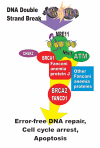The BRCA1/2 pathway prevents hematologic cancers in addition to breast and ovarian cancers
- PMID: 17683622
- PMCID: PMC1959234
- DOI: 10.1186/1471-2407-7-152
The BRCA1/2 pathway prevents hematologic cancers in addition to breast and ovarian cancers
Abstract
Background: The present study was designed to test the hypothesis that inactivation of virtually any component within the pathway containing the BRCA1 and BRCA2 proteins would increase the risks for lymphomas and leukemias. In people who do not have BRCA1 or BRCA2 gene mutations, the encoded proteins prevent breast/ovarian cancer. However BRCA1 and BRCA2 proteins have multiple functions including participating in a pathway that mediates repair of DNA double strand breaks by error-free methods. Inactivation of BRCA1, BRCA2 or any other critical protein within this "BRCA pathway" due to a gene mutation should inactivate this error-free repair process. DNA fragments produced by double strand breaks are then left to non-specific processes that rejoin them without regard for preserving normal gene regulation or function, so rearrangements of DNA segments are more likely. These kinds of rearrangements are typically associated with some lymphomas and leukemias.
Methods: Literature searches produced about 2500 epidemiology and basic science articles related to the BRCA pathway. These articles were reviewed and copied to a database to facilitate access. Meta-analyses of statistical information compared risks for hematologic cancers vs. mutations for the components in a model pathway containing BRCA1/2 gene products.
Results: Deleterious mutations of genes encoding proteins virtually anywhere within the BRCA pathway increased risks up to nearly 2000 fold for certain leukemias and lymphomas. Cancers with large increases in risk included mantle cell lymphoma, acute myeloid leukemia, acute lymphocytic leukemia, chronic lymphocytic leukemia, and prolymphocytic leukemia. Mantle cell lymphoma is defined by a characteristic rearrangement of DNA fragments interchanged between chromosomes 11 and 14. DNA translocations or rearrangements also occur in significant percentages of the other cancers.
Conclusion: An important function of the BRCA pathway is to prevent a subgroup of human leukemias and lymphomas that may involve non-random, characteristic gene rearrangements. Here, the genetic defect in BRCA pathway deficiencies is a chromosomal misrepair syndrome that may facilitate this subgroup of somatic cancers. Inactivation of a single gene within the pathway can increase risks for multiple cancers and inactivation of a different gene in the same pathway may have similar effects. The results presented here may have clinical implications for surveillance and therapy.
Figures

Similar articles
-
Absence of genomic BRCA1 and BRCA2 rearrangements in Ashkenazi breast and ovarian cancer families.Breast Cancer Res Treat. 2010 Sep;123(2):581-5. doi: 10.1007/s10549-010-0818-y. Epub 2010 Mar 11. Breast Cancer Res Treat. 2010. PMID: 20221693
-
BRCA1 and BRCA2 and the genetics of breast and ovarian cancer.Hum Mol Genet. 2001 Apr;10(7):705-13. doi: 10.1093/hmg/10.7.705. Hum Mol Genet. 2001. PMID: 11257103 Review.
-
BRCA1 and BRCA2 pathways and the risk of cancers other than breast or ovarian.MedGenMed. 2005 Jun 29;7(2):60. MedGenMed. 2005. PMID: 16369438 Free PMC article.
-
Expression and mutations of BRCA in breast cancer and ovarian cancer: Evidence from bioinformatics analyses.Int J Mol Med. 2018 Dec;42(6):3542-3550. doi: 10.3892/ijmm.2018.3870. Epub 2018 Sep 11. Int J Mol Med. 2018. PMID: 30221688
-
The relationship between the roles of BRCA genes in DNA repair and cancer predisposition.Trends Mol Med. 2002 Dec;8(12):571-6. doi: 10.1016/s1471-4914(02)02434-6. Trends Mol Med. 2002. PMID: 12470990 Review.
Cited by
-
Night Shift Work, DNA Methylation and Telomere Length: An Investigation on Hospital Female Nurses.Int J Environ Res Public Health. 2019 Jun 28;16(13):2292. doi: 10.3390/ijerph16132292. Int J Environ Res Public Health. 2019. PMID: 31261650 Free PMC article.
-
Cardiovascular Concerns in BRCA1 and BRCA2 Mutation Carriers.Curr Treat Options Cardiovasc Med. 2018 Mar 1;20(2):18. doi: 10.1007/s11936-018-0609-z. Curr Treat Options Cardiovasc Med. 2018. PMID: 29497862 Review.
-
Novel Germline Mutation of BRCA1 Gene in a 56-Year-Old Woman with Breast Cancer, Ovarian Cancer, and Diffuse Large B-Cell Lymphoma.Cancer Res Treat. 2015 Jul;47(3):534-8. doi: 10.4143/crt.2013.151. Epub 2014 Oct 17. Cancer Res Treat. 2015. PMID: 25483746 Free PMC article.
-
Fanconi anemia-D1 due to homozygosity for the BRCA2 gene Cypriot founder mutation: A case report.Oncol Lett. 2016 Jan;11(1):471-473. doi: 10.3892/ol.2015.3852. Epub 2015 Nov 2. Oncol Lett. 2016. PMID: 26834852 Free PMC article.
-
E. coli SbcCD and RecA control chromosomal rearrangement induced by an interrupted palindrome.Mol Cell. 2010 Jul 9;39(1):59-70. doi: 10.1016/j.molcel.2010.06.011. Mol Cell. 2010. PMID: 20603075 Free PMC article.
References
-
- Friedenson B. BRCA1 and BRCA2 pathways and the risk of cancers other than breast or ovarian. Medscape General Medicine MedgenMed. http://www.medscape.com http://www.medscape.com/viewarticle/505347 June 29, 2005. - PMC - PubMed
-
- Thompson D, Easton D, the Breast Cancer Linkage Consortium Cancer Incidence in BRCA1 mutation carriers. J Natl Cancer Inst. 2002;18:1358–1365. - PubMed
-
- Walsh T, Casadei S, Coats K, Swisher E, Stray S, Higgins J, Roach K, Mandell J, Lee M, Ciernikova S, Foretova L, Soucek P, King M-C. Spectrum of mutations in BRCA1, BRCA2, CHEK2, and TP53 in families at high risk for breast cancer. JAMA. 2006;295:1379–1388. doi: 10.1001/jama.295.12.1379. - DOI - PubMed
Publication types
MeSH terms
Substances
LinkOut - more resources
Full Text Sources
Other Literature Sources
Medical
Miscellaneous

